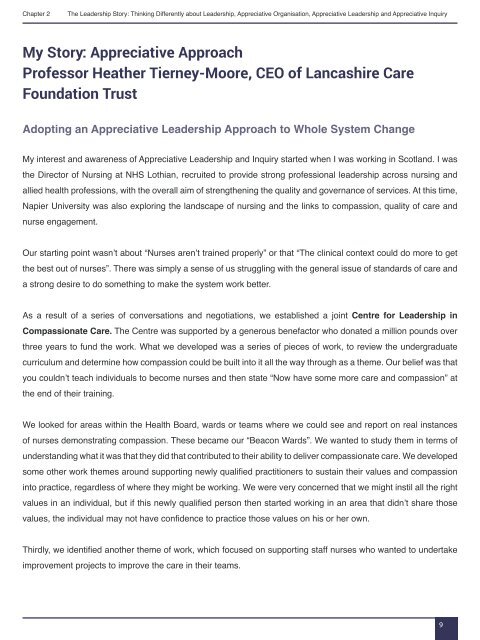Appreciative-Leadership
Appreciative-Leadership
Appreciative-Leadership
Create successful ePaper yourself
Turn your PDF publications into a flip-book with our unique Google optimized e-Paper software.
Chapter 2<br />
The <strong>Leadership</strong> Story: Thinking Differently about <strong>Leadership</strong>, <strong>Appreciative</strong> Organisation, <strong>Appreciative</strong> <strong>Leadership</strong> and <strong>Appreciative</strong> Inquiry<br />
My Story: <strong>Appreciative</strong> Approach<br />
Professor Heather Tierney-Moore, CEO of Lancashire Care<br />
Foundation Trust<br />
Adopting an <strong>Appreciative</strong> <strong>Leadership</strong> Approach to Whole System Change<br />
My interest and awareness of <strong>Appreciative</strong> <strong>Leadership</strong> and Inquiry started when I was working in Scotland. I was<br />
the Director of Nursing at NHS Lothian, recruited to provide strong professional leadership across nursing and<br />
allied health professions, with the overall aim of strengthening the quality and governance of services. At this time,<br />
Napier University was also exploring the landscape of nursing and the links to compassion, quality of care and<br />
nurse engagement.<br />
Our starting point wasn’t about “Nurses aren’t trained properly” or that “The clinical context could do more to get<br />
the best out of nurses”. There was simply a sense of us struggling with the general issue of standards of care and<br />
a strong desire to do something to make the system work better.<br />
As a result of a series of conversations and negotiations, we established a joint Centre for <strong>Leadership</strong> in<br />
Compassionate Care. The Centre was supported by a generous benefactor who donated a million pounds over<br />
three years to fund the work. What we developed was a series of pieces of work, to review the undergraduate<br />
curriculum and determine how compassion could be built into it all the way through as a theme. Our belief was that<br />
you couldn’t teach individuals to become nurses and then state “Now have some more care and compassion” at<br />
the end of their training.<br />
We looked for areas within the Health Board, wards or teams where we could see and report on real instances<br />
of nurses demonstrating compassion. These became our “Beacon Wards”. We wanted to study them in terms of<br />
understanding what it was that they did that contributed to their ability to deliver compassionate care. We developed<br />
some other work themes around supporting newly qualified practitioners to sustain their values and compassion<br />
into practice, regardless of where they might be working. We were very concerned that we might instil all the right<br />
values in an individual, but if this newly qualified person then started working in an area that didn’t share those<br />
values, the individual may not have confidence to practice those values on his or her own.<br />
Thirdly, we identified another theme of work, which focused on supporting staff nurses who wanted to undertake<br />
improvement projects to improve the care in their teams.<br />
9


